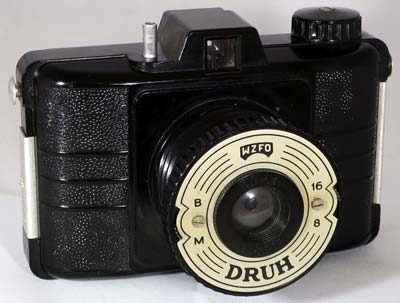WZFO Druh
Specification


| Manufacturer | : | WZFO |
|---|---|---|
| Produced | : | 1956 |
| Classification | : | Medium Format |
| Body Type | : | Extending Helix |
| Construction | : | Bakelite |
| Film Type | : | 120 |
| Film Width | : | 62mm |
| ImageSize | : | 6x6cm or 4x6cm(with mask) |
| No. of Images | : | 12/16 |
| Lens Type | : | Bilar |
| Focus Type | : | Fixed |
| Focal Length | : | 65mm |
| Focal Range | : | 2.75m - inf. |
| Aperture Type | : | Multihole |
| Aperture | : | f/8, f/16 |
| Shutter Type | : | Rotary |
| Shutter Speeds | : | T, I*(1/60 s) |
| Size Open (w x h x d) | : | 140 x 90 x 85 mm |
| Size Closed (w x h x d) | : | 140 x 90 x 55 mm |
| Weight | : | 295g |
| * Measured on this camera | ||
Art Deco Credentials
![]()
![]()
Acceptable: Modest and restricted
- Designed after the main Art Deco period.
- Curvilinear body design in Streamline Moderne style
- Leather pattern in Bakelite
- Horizontal ribbing to Bakelite
- Parallel arcs on faceplate
- Curvilinear edging on faceplate
Description
This WZFO Druh was made by the Polish firm Warszawskie Zaklady Fotooptyczne. It is a licenced version of the Pouva Start. Other versions of this camera were produced for various other camera makers under licence until 1972. It is estimated that 1.7 million Starts were sold. Here is a nice article (in German) showing all the versions of the Pouva Start including a syncho flash version on the WZFO Druh - Versions of the Pouva Start.
The camera is fairly simple. It takes 12 6cm x 6cm or 16 4x6cm pictures on 120 roll film. To use 4x6cm you need to fit a mask to the film plane. There are two red windows on the back for use with the different formats. There is an aluminium memo pointer in case you forget which format you are using.
On the top is the shutter release button. Also on the top is an optical reverse telescopic viewfinder and the film advance wheel. On the bottom is the tripod mount. There are small aluminium lugs on the side for a strap.
On the lens barrel's front plate there is a switch for choosing the Instant (1/25s) 'M' or Bulb 'B' function. The aperture is changed by a switch which is annotated with '8'(f/8) and '16' (f/16). The lens is a Bilar having two lenses, one in front and one behind the aperture.
The camera's most characteristic feature is that the lens is deployed by turning the barrel counter-clockwise by 360 degrees. The helical screw moves the lens outward into the working position. It is not possible to fire the shutter until the lens is completely deployed.
How to Use
This camera takes 120 film which easily available from most photographic outlets. Don't forget to cover the red windows with black electrical tape except when advancing the film in low light. Modern film is sensitive to red light.
Shutter speeds is 1/60s. The aperture values available are f/8, f/16.
If you don't want to bother with an exposure meter, follow the guide shown. It is based on the 'Sunny 16' rule. Film is so forgiving and will produce acceptable results even when overexposed by 2 or 3 stops or underexposed by 1 stop.
Remember that the exposure guide in the camera user manual may not be helpful as it is based on the use of old film with a low ISO value.
The tables assume that the sun is at least 30 degrees above the horizon - that's 10am - 5pm on a summer's day (May-August) in the UK.
Because of the slow speed of this camera, you may need a tripod or hold the camera firmly against your face to stop blur through shake.
Using ISO 100/125 film - shutter speed 1/60s
| Weather Conditions | Shadow Detail | Aperture | Exposure |
|---|---|---|---|
 Sunny SunnySnow/Sand | Dark with sharp edges | f/16 | +2 Stops Overexposed Acceptable |
 Sunny Sunny | Distinct | f/16 | +1 Stop Overexposed Acceptable |
 Slight Overcast Slight Overcast | Soft around edges | f/16 | Good |
 Overcast Overcast | Barely visible | f/8 | +1 Stop Overexposed Acceptable |
 Heavy Overcast Heavy Overcast | None | f/8 | Good |
 Open Shade Open Shade/Sunset | None | f/8 | -1 Stop Underexposed Acceptable |